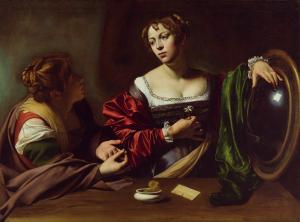--On Loan from the Detroit Institute of Arts, Fewer Than 10 Paintings
by the Baroque Master Are On View in the US--

Dallas, TX—June 18, 2019—This summer, visitors to the Dallas Museum of Art have the rare opportunity to see an extraordinary work by the Old Master painter Caravaggio. One of the most influential figures in the history of European art, he is renowned as one of the greatest Baroque painters of the 17th century along with Rubens, Velázquez, Rembrandt, and Poussin. Fewer than 10 paintings by Caravaggio are housed in the US, on view in the collections of only six museums.
Martha and Mary Magdalene (c. 1598), on loan to the DMA from the Detroit Institute of Arts, is a masterpiece from Caravaggio’s early career in Rome. The painting depicts Mary Magdalene, considered by the Catholic Church at the time to be a prostitute, experiencing a spiritual awakening as her sister Martha counts on her fingers the reasons she should convert. Caravaggio conveys the moment of Mary’s conversion—a challenging subject—through his treatment of light, which casts a divine glow on the reformed sinner.
On view June 23–September 22, 2019, Caravaggio: Martha and Mary Magdalene is curated by Julien Domercq, the DMA’s new Lillian and James H. Clark Assistant Curator of European Art, who joined the Museum last month after serving as the Vivmar Curatorial Fellow at the National Gallery in London from 2016 to 2018. Domercq’s appointment includes a focus on the DMA’s Old Master collection, rethinking its presentation and interpretation in the galleries and strategizing on collection growth in this area. This is his first exhibition project at the DMA and it is included in free general admission.
Michelangelo Merisi da Caravaggio (1571–1610) was active in Italy between 1592 and 1610. He revolutionized painting and laid the foundation for 17th-century Baroque art through his theatrical compositions and gritty realism observed from life. At the heart of Caravaggio’s groundbreaking style are his reduced color schemes, somber backgrounds, and dramatic lighting effects produced by sharp light and dark contrasts (chiaroscuro). The artist’s creation of a shallow, stage-like setting pushes the figures up close to the viewer, as though the event is unfolding in our own space and time.
Visitors can learn more about the life, career, and importance of Caravaggio in a series of public programs from July through September. Confirmed events, with more to come, can be found at DMA.org. They currently include:
Tuesday, July 16, 7:30 p.m.
Arts & Letters Live: Caravaggio’s Life and Art
Julien Domercq, the DMA’s Lillian and James H. Clark Assistant Curator of European Art, will start by discussing Caravaggio’s painting Martha and Mary Magdalene (c. 1598). Andrew Graham-Dixon, one of the leading art critics and presenters of arts television in the English-speaking world, will then talk about his acclaimed biography Caravaggio: A Life Sacred and Profane, which was shortlisted for the Samuel Johnson Prize for nonfiction and was a New York Times Notable Book.
Wednesday, August 7, 12:15 p.m.
Gallery Talk: Caravaggio with Julien Domercq
Thursday, September 19, 7:00 p.m.
Exhibition Talk: Caravaggio's Revolutionary Road with Eve Straussman-Pflanzer, Head of the European Art Department and Elizabeth and Allan Shelden Curator of European Paintings at the Detroit Institute of Arts. This event is sponsored by the Consolato Generale D’Italia Houston.
Image: Michelangelo Merisi da Caravggio, Martha and Mary Magdalene, c. 1598, oil and tempera on canvas, Detroit Institute of Arts, Gift of the Kresge Foundation and Mrs. Edsel B. Ford, 73.268
About the Dallas Museum of Art
Established in 1903, the Dallas Museum of Art (DMA) is among the 10 largest art museums in the country and is distinguished by its commitment to research, innovation, and public engagement. At the heart of the Museum and its programs is its global collection, which encompasses more than 24,000 works and spans 5,000 years of history, representing a full range of world cultures. Located in the nation’s largest arts district, the Museum acts as a catalyst for community creativity, engaging people of all ages and backgrounds with a diverse spectrum of programming, from exhibitions and lectures to concerts, literary events, and dramatic and dance presentations. Since the Museum’s return to free general admission in 2013, the DMA has welcomed more than 4 million visitors, including more than 800,000 in 2018. For more information, visit DMA.org.
The Dallas Museum of Art is supported, in part, by the generosity of DMA Members and donors, the citizens of Dallas through the City of Dallas Office of Cultural Affairs, and the Texas Commission on the Arts.
###